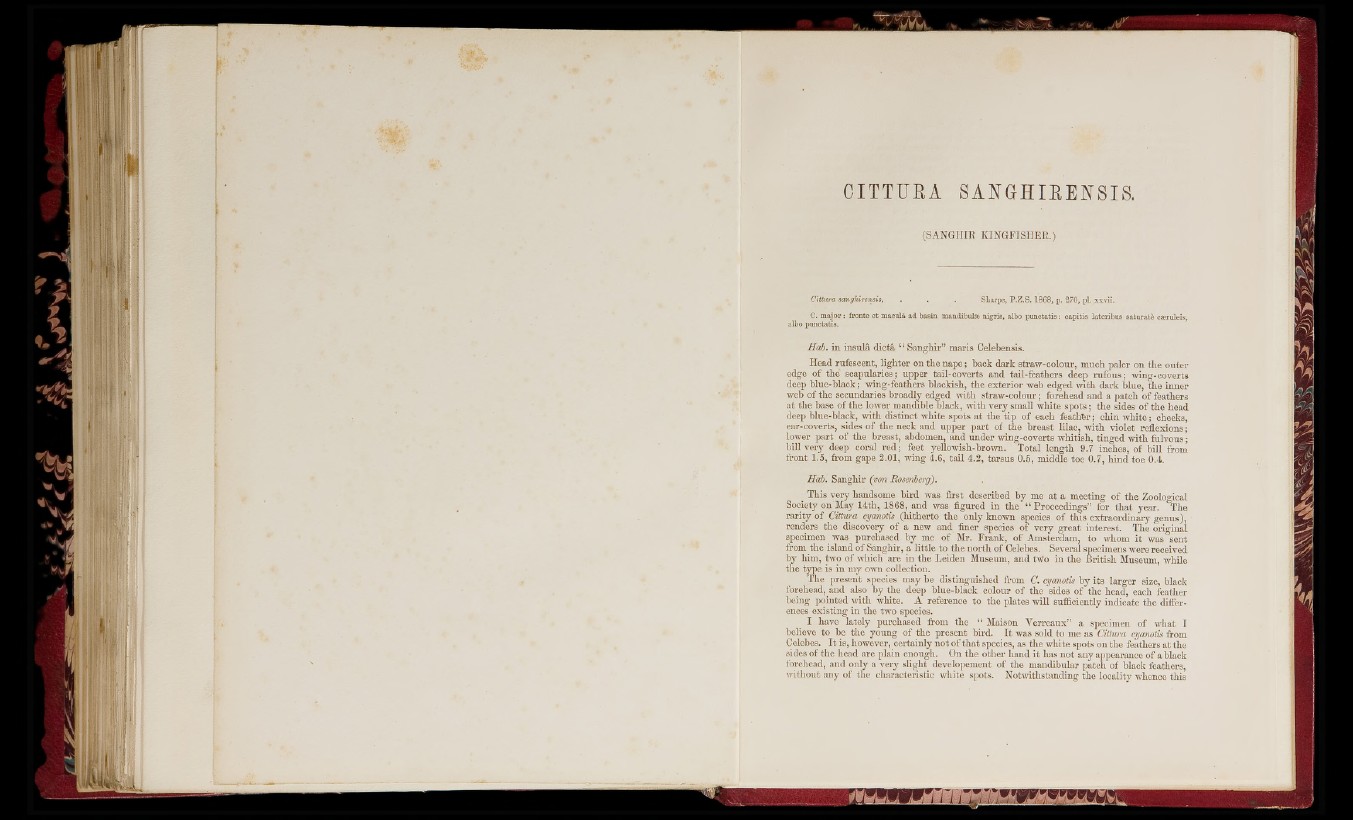
C I T TURA SANGHI R ENS I S .
(SAN GH IR K IN G F ISH E R .)
Sharpe, P.Z.S. 1868, p. 270j pl. xxvii.
C. major : fronte et maculâ ad basin mandibnlæ nigris, albo punctatis : capitis lateribus saturatè cæruleis,
albo punctatis.
Head rufescent, lig h te r on th e n ap e ; back dark straw-colour, m uch p aler on the o u ter
_ o f th e scapularies; u pper tail-co v erts and tail-feathers deep ru fo u s ; wing-coverts
deep blu e-b lack ; wing-feathers blackish, th e ex te rio r web edged w ith dark blue, th e in n er
web o f the secundaries broadly edged w ith straw-co lo u r; forehead and a patch o f feathers
a t th e base o f th e lower mandible black, with v e ry small white sp o ts ; th e sides o f th e head
llO + TT-rel- TTTl-.l+re 0.rere1-re re+ *lrere « rei* re re rel* J?re re fll. V. re . deep blue-black, w ith d istin c t white spots a t the tip o f each feath b r;chi_n _w_1h_ Ji ftl *e ; c.1h. e. e.1ks,
ear-coverts, sides o f th e neck and u pper p a rt of th e b rea st lilac, ivith violet reflex io n s;
loAver p a rt o f the breast, abdomen, and u n d e r wing-coverts whitish, tin g e d with fu lv o u s ;
b ill very deep coral r e d ; feet yellowish-brown. Total len g th 9.7 inches, o f b ill from
f ro n t 1.5, from gape 2.01, win g 4.6, ta il 4.2, tarsu s 0.5, middle toe 0.7, h in d toe 0.4.
Hah. S anghir (
This v e iy handsome b ird was first described b y me a t a meeting o f the Zoological
Society on May 14th, 1868, and was figured in th e “ Proceedings” for th a t year. The
r a r ity o f Cittura cyanotis (h ith e rto th e only known species o f th is e x tra o rd in a iy g en u s),
renders th e discovery o f a new and finer species o f v e ry g re a t interest. The o riginal
specimen _ was purchased by me o f J lr . F ran k , o f Amsterdam, to whom i t ivas sent
from the island o f Sanghir, a little to th e n o rth o f Celebes. Several specimens were received
by him, two o f Avhicli are in th e Leiden Museum, and tWo in th e B ritish J lu seum , while
■ 3 in my own collection.
present species may be distin g u ish ed from C. cyanotis b y its larg e r size, black
forehead, and also by th e deep blue-black colour o f the sides o f th e head, each feather
being pointed with white. A reference to the plates will sufficiently indicate the difier-
ences ex istin g in the two species.
I have lately purchased from the “ Maison V e rreau x ” a specimen o f what I
believe to be the young o f th e present bird. I t was sold to me as Ciiiura cyanotis irom
Celebes. I t is, however, certain ly n o t o f th a t species, as the Avhite spots on the feathers a t the
sides o f th e hca.d are plain enough. On the o th er hand i t has n o t any appearance o f a black
forehead, and only a v e ry s lig h t developement o f the m andibular patch of biack feathers,
Avithout any o f the characteristic Avhite spots. NotAvithstanding the locality Avhencc this